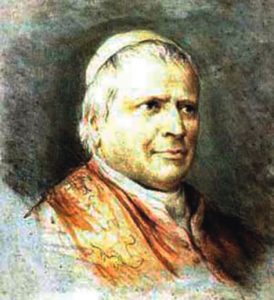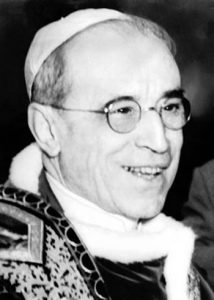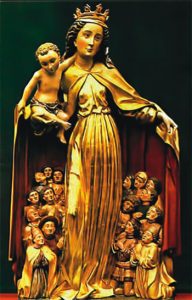Mary for Today – Mary in the Year of Faith
New Marian Dogmas Unlikely
This article is a response to a request to reflect on the call for new Marian dogmas. It is based on a conviction that rather than go down new paths we need to give life to the truths about Mary we already have, to let them speak anew into our 21st century church and faith. We need first to consider some issues surrounding dogmas and second listen to what the church says about a renewed approach to Mary.
Tangled History
 Church authority has an obligation to strive for pastoral reasons to make the way to salvation less onerous. Faith must remain a reasonable act as well as a graced act. The two last doctrines have a chequered history: the Immaculate Conception was totally unknown to the Fathers of the Church and was explicitly rejected by major theologians in the Middle Ages: Saints Bernard, Thomas Aquinas, Bonaventure. Rome forbade the term, Immaculate Conception, in 1644, declaring that one should talk of the Conception of the Immaculate Virgin. It is the virgin who is immaculate, not the biological phenomenon of her conception. As for the Assumption, the stories that tell of this are of apocryphal origin.
Church authority has an obligation to strive for pastoral reasons to make the way to salvation less onerous. Faith must remain a reasonable act as well as a graced act. The two last doctrines have a chequered history: the Immaculate Conception was totally unknown to the Fathers of the Church and was explicitly rejected by major theologians in the Middle Ages: Saints Bernard, Thomas Aquinas, Bonaventure. Rome forbade the term, Immaculate Conception, in 1644, declaring that one should talk of the Conception of the Immaculate Virgin. It is the virgin who is immaculate, not the biological phenomenon of her conception. As for the Assumption, the stories that tell of this are of apocryphal origin.
The Orthodox Church was not prepared to accept the definitions of these doctrines; the consensus of Anglicans and Protestants was against their formulations. It is never good to deepen the separation between Christian believers. The very manner of making dogmas changed between the French Revolution and the 19th century; when Pius IX proclaimed the Immaculate Conception it was the first time that a bishop of Rome acted without the support of a council to define a doctrine as being essential to the Catholic faith, adding one more stone to the defensive wall against the perceived assault of the modern world on the church.
New Factors
While there was a consultation of bishops prior to the proclamation of the Immaculate Conception (1854) the dubious element was the pope’s already publicly known desire to define the doctrine. The most disturbing feature was not the preparation, which was thorough, nor even the way it was proclaimed, though it is generally better for a dogma of faith to be proclaimed in council as an expression of the universal church than by the bishop of Rome speaking ex cathedra. The problem lay in the bull itself, Ineffabilis Deus.
“The Catholic Church … has ever held as divinely revealed and as contained in the deposit of heavenly revelation this doctrine concerning the original innocence of the august virgin” just does not apply to the early or even the middle times in the church. The appeal is made to liturgical practice which again has a late starting point. “This doctrine always existed in the Church as a doctrine that has been received from our ancestors, and has been stamped with the character of revealed doctrine”. The development of doctrine becomes a controversial theological issue.
Assumption
The bull in which Pius XII defined the doctrine of Mary’s Assumption was promulgated in 1950 on the Feast of All Saints. For the pope the Assumption of Mary flows from her Immaculate Conception, with both connecting to her mission as Theotokos, ‘God bearer.’ As the Immaculate Conception was a pure, undeserved gift, so was the Assumption. The end balances the beginning. The two dogmas are then seen to underline the separation of Mary from the ordinary conditions of life in the people of God. Unlike the 1854 definition, no attempt was made to find the doctrine of Mary’s Assumption in the Scriptures. While the wording asserts Mary’s Assumption “is based on the Sacred Writings”, no attempt is made to identify the exact place. It is entirely on tradition that the text bases the doctrine.
 Pius XII believed the definition of the Assumption tallied with the needs of the church in the mid 20th century, and interpreted these needs in light of his experience and piety: World War II, the Communist Party in Italy, the rise of the Soviet Union, existentialism. The definition owes much to the personal piety of the pope: “the moment appointed in the plan of divine providence for the solemn proclamation of this outstanding privilege of the Virgin Mary has already arrived”.
Pius XII believed the definition of the Assumption tallied with the needs of the church in the mid 20th century, and interpreted these needs in light of his experience and piety: World War II, the Communist Party in Italy, the rise of the Soviet Union, existentialism. The definition owes much to the personal piety of the pope: “the moment appointed in the plan of divine providence for the solemn proclamation of this outstanding privilege of the Virgin Mary has already arrived”.
Better Expression
The two modern definitions about Mary that were made in the Catholic Church stand in need of rewriting. Such a rewriting ought to be done ecumenically, in such a way that the whole Christian tradition contributes to it. The point is not to renounce one’s own tradition but to incorporate and own the insights of others. Certainly this will be a slow process and may be the ultimate test of ecumenical commitment. Mary as a Woman for Others is a treasure that Catholicism has to share with her Christian children in other denominations.
Not a Path to go down
Given this background of how we got to the two dogmas of recent times, where to from here? The early dogmas in the church centred around Christ and Trinity as core to Christian belief. Paul VI laid down four guidelines to shape the future direction for Mariology: Scriptural, ecumenical, liturgical, and anthropological. The drive to have Mary declared Mediatrix or Co-Redemptrix founders significantly on the first (and second) principle. It violates Scripture: “There is one God; there is also one mediator between God and humankind, Christ Jesus, himself human, who gave himself as a ransom for all” (1 Timothy 2:5). The two most recent dogmas did not violate Scripture; they just were not in Scripture. It would not be fair to the memory of Mary to spend two thirds of a bull of definition trying to explain what we are not saying and one third of what we are saying about Mary’s unique contribution to her Son’s role as Mediator and Redeemer.
Such titles are expressions of personal piety; they should not be taken literally lest they seem to detract from the unique and universal mediatorship of Christ. It is dangerous to place a mediator between Christ and the faithful, or between the faithful and Christ, as though to suggest that we cannot reach Christ without his mother’s mediation. Mary can stand with us as we turn to Christ our mediator. That was Vatican II’s gift in giving her back to us as Mother of and in the Church.
Mary can stand with us as we turn to Christ our mediator. That was Vatican II’s gift in giving her back to us as Mother of and in the Church.
A major topic for ecumenical dialogue among Christian believers and churches will be the significance of the Virgin Mary, Mother of God, for the Christian faith.
Mary, an Ideal to Aspire to
Through history Mary has been shaped by the imaginations of many generations of Christians. She has been the ideal of the discipleship to which the Church aspires. Every age has unconsciously formed its image of Mary according to its own ideal of discipleship. What would our 21st century ideal of a church with the face of Mary look like? Like a good mother listening to all her children, not just those who agree with a particular ideological position? Taking seriously the Word of her Son in Scripture? Ministry for service rather than power, prestige, and position? On the side of her forgotten and betrayed daughters and sons? Hearing Pope John Paul II’s reminder that the Church was Marial before it was Petrine? After the most bitter battle of Vatican II the chapter on Mary, which says more about her than any previous council, ended up in the document on the Church, Lumen Gentium. That is the context for future reflection and direction.
Sources: Katleen Coyle: Mary the embodiment of God’s Love.
George H. Tavard: The Thousand Faces of Mary.


 Entries(RSS)
Entries(RSS)